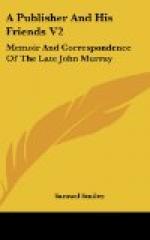On the other hand, Bernard Barton wrote to Mr. Murray, and said that he had “heard that James Hogg, the Ettrick Shepherd, was the author of ‘Tales of my Landlord,’ and that he had had intimation from himself to that effect,” by no means an improbable story considering Hogg’s vanity. Lady Mackintosh also wrote to Mr. Murray: “Did you hear who this new author of ‘Waverley’ and ‘Guy Mannering’ is? Mrs. Thomas Scott, as Mr. Thomas Scott assured Lord Selkirk (who had been in Canada), and his lordship, like Lord Monboddo, believes it.” Murray again wrote to Blackwood (February 15, 1817): “What is your theory as to the author of ‘Harold the Dauntless’? I will believe, till within an inch of my life, that the author of ‘Tales of my Landlord’ is Thomas Scott.”
Thus matters remained until a few years later, when George IV. was on his memorable visit to Edinburgh. Walter Scott was one of the heroes of the occasion, and was the selected cicerone to the King. One day George IV., in the sudden and abrupt manner which is peculiar to our Royal Family, asked Scott point-blank: “By the way, Scott, are you the author of ’Waverley’?” Scott as abruptly answered: “No, Sire!” Having made this answer (said Mr. Thomas Mitchell, who communicated the information to Mr. Murray some years later), “it is supposed that he considered it a matter of honour to keep the secret during the present King’s reign. If the least personal allusion is made to the subject in Sir Walter’s presence, Matthews says that his head gently drops upon his breast, and that is a signal for the person to desist.”
With respect to the first series of the “Tales of my Landlord,” so soon as the 6,000 copies had been disposed of which the author, through Ballantyne, had covenanted as the maximum number to be published by Murray and Blackwood, the work reverted to Constable, and was published uniformly with the other works by the author of “Waverley.”
CHAPTER XVIII
ALLIANCE WITH BLACKWOOD—BLACKWOOD’S “EDINBURGH MAGAZINE”—TERMINATION OF PARTNERSHIP
We have already seen that Mr. Murray had some correspondence with Thomas Campbell in 1806 respecting the establishment of a monthly magazine; such an undertaking had long been a favourite scheme of his, and he had mentioned the subject to many friends at home as well as abroad. When, therefore, Mr. Blackwood started his magazine, Murray was ready to enter into his plans, and before long announced to the public that he had become joint proprietor and publisher of Blackwood’s Edinburgh Magazine.
There was nothing very striking in the early numbers of the Magazine, and it does not appear to have obtained a considerable circulation. The first editors were Thomas Pringle, who—in conjunction with a friend—was the author of a poem entitled “The Institute,” and James Cleghorn, best known as a contributor to the Farmers’ Magazine. Constable, who




